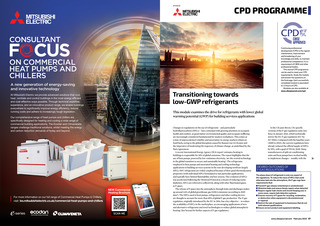


SPONSOR CPD PROGRAMME Continuing professional development (CPD) is the regular maintenance, improvement and broadening of your knowledge and skills, to maintain professional competence. It is a requirement of CIBSE and other professional bodies. This Journal CPD programme can be used to meet your CPD requirements. Study the module and answer the questions on the final page. Each successfully completed module is equivalent to 1.5 hours of CPD. Modules are also available at www.cibsejournal.com/cpd Transitioning towards low-GWP refrigerants This module examines the drive for refrigerants with lower global warming potential (GWP) for building services applications Changes to regulations on the use of refrigerants and particularly hydrofluorocarbons (HFCs) have coincided with growing attention on occupant health and comfort, as good indoor environmental quality and occupant wellbeing are increasingly considered fundamental for modern workplaces. This comes at a time of unprecedented volatility and uncertainty in energy markets reliant on fossil fuels, owing to the global disruption caused by Russias war in Ukraine and the imperative of moderating the trajectory of climate change, as underlined by the Paris Agreement. A recent International Energy Agency (IEA) report1 estimates heating in buildings is responsible for 10% of global emissions. The report highlights that the use of heat pumps, powered by low-emissions electricity, are the central technology in the global transition to secure and sustainable heating. The refrigerants employed in heat pumps and associated heating and cooling technology applications in building services systems in the non-developing world are largely HFCs. HFC refrigerants are widely employed because of their good thermodynamic properties (with individual HFCs formulated to suit particular applications), and typically have limited flammability and low toxicity. The evolution of HFCs was accelerated following the Montreal Protocol as a means of reducing ozone depletion. HFCs are referred to collectively, along with other fluorinated gases, as F-gases. The release of F-gases into the atmosphere through leaks and discharges makes up around 2.4% of global greenhouse gas (GHG) emissions (according to 2019 data2). The HFCs used in heat pumps, refrigerators and other cooling devices are thought to account for more than 85% of global F-gas production. The F-gas regulation, originally introduced by the EU in 2014, has a key objective to reduce the availability of HFCs in the marketplace, so encouraging applications of new and alternative refrigerants and novel technologies to reduce global atmospheric heating. (See boxout for further aspects of F-gas regulation.) In the UK post-Brexit, UK-specific versions of the F-gas regulation came into force in January 2021, which technically mirror the EU F-gas regulation (EU No 517/2014). Compared with the baseline years (2009 to 2012), the current regulations have already reduced the official supply of HFCs by 55%, with a goal of 79% by 2030. Many manufacturers of split air conditioning units and heat pumps have worked swiftly to implement changes notably with the DESIRED OUTCOMES OF F-GAS REGULATIONS The phase down of refrigerants is only one aspect of the regulations. To reduce the mass of HFCs that could otherwise leak into the atmosphere, the F-gas regs have requirements that: Prevent F-gas release (intentional or unintentional) Minimise leaks and ensure timely repairs when detected Require regular leak checks and record-keeping and, in some cases, require leak detection systems Ensures recovery of F-gases for recycling, reclamation, or destruction when equipment is decommissioned or repaired Restrict the sale of equipment to businesses that do not hold relevant qualifications Ensure correct product and equipment labelling. www.cibsejournal.com February 2023 61